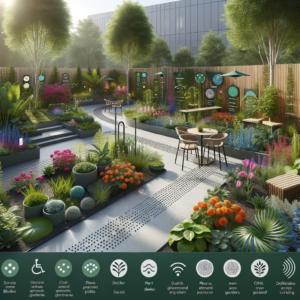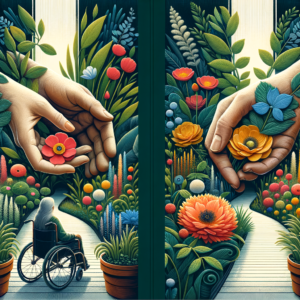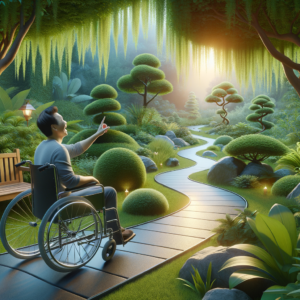An adaptive garden is designed to be accessible and enjoyable for people of all abilities, including those with mobility challenges or other disabilities. A crucial element of these gardens is the incorporation of well-designed rest areas. These spaces provide not only a place to relax and enjoy the garden but also serve as important points for recovery, socialization, and sensory engagement. This comprehensive guide will explore how to effectively incorporate rest areas into your adaptive garden, ensuring comfort, accessibility, and enhanced enjoyment for all visitors.
Importance of Rest Areas in Adaptive Gardens
- Physical Recovery: Provide spots for resting and regaining energy
- Sensory Engagement: Offer places to sit and fully experience the garden
- Social Interaction: Create spaces for gathering and conversation
- Safety: Ensure users have nearby spots to rest if fatigued
- Enjoyment Enhancement: Allow for prolonged garden visits
- Therapeutic Value: Support mental relaxation and stress reduction
Designing Accessible Rest Areas
- Wheelchair Accessibility:
- Clear, level access paths
- Firm, stable surfaces around seating areas
- Diverse Seating Heights: Accommodate different needs and preferences
- Armrests and Backrests: Provide support for ease of sitting and standing
- Space for Mobility Aids: Ensure room for wheelchairs, walkers, or scooters
- Clear Sightlines: Allow users to observe garden activities while resting
Types of Seating Options
- Benches:
- With and without backs
- Various lengths to accommodate groups or individuals
- Chairs: Moveable for flexibility
- Built-in Seating: Integrated with raised beds or retaining walls
- Swing Seats: For gentle motion, ensure they’re stable and accessible
- Leaning Rails: For brief rests along pathways
- Adaptable Furniture: Adjustable height or convertible options
Shade and Shelter Considerations
- Pergolas: Provide dappled shade and support for climbing plants
- Umbrellas: Moveable shade options
- Shade Sails: Modern, flexible shading solution
- Natural Shade: Strategic placement near trees
- Garden Structures: Gazebos or pavilions for more substantial shelter
- All-Weather Options: Consider covered areas for year-round use
Incorporating Sensory Elements
- Fragrant Plants: Place aromatic species near seating
- Water Features: Add soothing sounds of trickling water
- Textured Surfaces: Incorporate varied textures in seating and surrounding areas
- Bird Feeders: Attract wildlife for visual and auditory interest
- Wind Chimes: Create gentle, calming sounds
- Sensory Plants: Include plants with interesting textures within reach
Safety Features for Rest Areas
- Non-Slip Surfaces: Ensure flooring is safe in all weather conditions
- Adequate Lighting: Illuminate areas for evening use and safety
- Handrails: Provide support where needed, especially on slopes
- Visible Edges: Use contrasting colors to define edges of seating areas
- Emergency Call Systems: Consider installing for larger gardens
- First Aid Stations: Locate near main rest areas
Positioning Rest Areas in the Garden
- Regular Intervals: Place seating every 25-30 feet along paths
- Key Viewpoints: Position to capture the best garden views
- Near Activity Areas: Provide seating close to gardening spaces
- Quiet Retreats: Create secluded spots for solitude
- Social Hubs: Design larger areas for group gatherings
- Entrances and Exits: Offer resting spots at garden entry and exit points
Materials and Durability
- Weather-Resistant Materials: Choose options like treated wood, metal, or recycled plastic
- Comfort Considerations: Ensure materials don’t become too hot or cold
- Low-Maintenance Finishes: Select easy-to-clean surfaces
- Sturdy Construction: Ensure stability for safety and longevity
- Eco-Friendly Options: Consider sustainable materials like bamboo or reclaimed wood
- Aesthetics: Choose materials that complement the garden design
Seasonal Adaptations for Rest Areas
- Winter Comfort: Provide windbreaks and consider heated seating options
- Summer Cooling: Ensure adequate shade and ventilation
- Spring and Fall Flexibility: Removable cushions or covers for changing weather
- Year-Round Interest: Position seating to enjoy seasonal garden changes
- Adaptable Shelters: Retractable or adjustable shade structures
Therapeutic Benefits of Garden Rest Spaces
- Stress Reduction: Quiet spaces for meditation and relaxation
- Nature Connection: Opportunities for close observation of plants and wildlife
- Physical Therapy: Seating that supports gentle exercises or stretching
- Emotional Well-being: Creating a sense of peace and belonging
- Cognitive Stimulation: Areas for nature-based activities or reading
- Social Health: Spaces that encourage interaction and community building
Maintenance and Upkeep
- Regular Cleaning: Keep seating areas clean and inviting
- Inspection Schedule: Check for wear and tear, especially on moving parts
- Seasonal Care: Protect or store certain elements during harsh weather
- Plant Management: Maintain nearby plants to prevent overgrowth
- Surface Maintenance: Repair any cracks or unevenness in flooring
- Refresh and Renew: Periodically update cushions or paint for a fresh look
Social Aspects of Garden Rest Areas
- Conversation Nooks: Create intimate spaces for small group chats
- Community Gathering Spots: Larger areas for events or classes
- Intergenerational Design: Accommodate needs of various age groups
- Cultural Considerations: Reflect community diversity in design elements
- Educational Opportunities: Incorporate informational displays or plant labels
- Volunteer Engagement: Areas for garden volunteers to rest and socialize
Conclusion
Incorporating well-designed rest areas is essential in creating truly adaptive and inclusive gardens. These spaces not only provide necessary points of respite but also enhance the overall garden experience, encouraging longer visits and deeper engagement with nature. By carefully considering accessibility, comfort, safety, and sensory engagement, you can create rest areas that serve a diverse range of visitors, from those with mobility challenges to individuals seeking a peaceful retreat.
Remember that the best rest areas are those that seamlessly blend with the garden’s overall design while meeting the specific needs of your community. Regular feedback from users can help you continually improve and adapt these spaces. With thoughtful planning and implementation, rest areas can transform your adaptive garden into a more welcoming, comfortable, and therapeutic environment for all.
FAQ
- Q: How many rest areas should I include in my adaptive garden? A: A good rule of thumb is to have seating available every 25-30 feet along pathways, with additional rest areas at key garden features or viewpoints.
- Q: What’s the ideal height for accessible seating? A: A range of 17-19 inches is generally suitable for most adults, but providing varied heights (including some at 21-23 inches) can accommodate different needs.
- Q: How can I make rest areas inviting during colder months? A: Consider adding windbreaks, using materials that don’t retain cold, and even incorporating outdoor heating elements for year-round comfort.
- Q: Are there plants I should avoid near rest areas? A: Avoid plants with thorns, those known for attracting stinging insects, or plants that produce a lot of pollen, which might affect allergy sufferers.
- Q: How can I encourage social interaction in garden rest areas? A: Design some seating in conversational groupings, create circular or semi-circular arrangements, and consider adding features like game tables or communal art projects.



